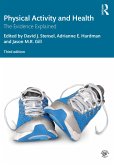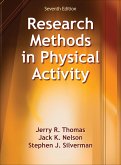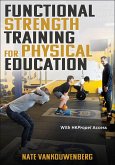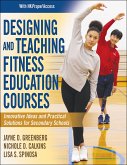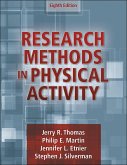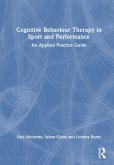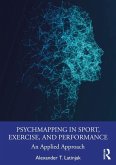- Broschiertes Buch
- Merkliste
- Auf die Merkliste
- Bewerten Bewerten
- Teilen
- Produkt teilen
- Produkterinnerung
- Produkterinnerung
Measurement and Evaluation in Human Performance, Sixth Edition With HKPropel Access, teaches the fundamentals of collecting and analyzing human performance data by focusing on the concepts of reliability and validity. It features practical applications in kinesiology, physical education, and more.
Andere Kunden interessierten sich auch für
![Physical Activity and Health Physical Activity and Health]() Physical Activity and Health79,99 €
Physical Activity and Health79,99 €![Research Methods in Physical Activity Research Methods in Physical Activity]() Jerry R. ThomasResearch Methods in Physical Activity122,99 €
Jerry R. ThomasResearch Methods in Physical Activity122,99 €![Functional Strength Training for Physical Education Functional Strength Training for Physical Education]() Nate VanKouwenbergFunctional Strength Training for Physical Education53,99 €
Nate VanKouwenbergFunctional Strength Training for Physical Education53,99 €![Designing and Teaching Fitness Education Courses Designing and Teaching Fitness Education Courses]() Jayne D. GreenbergDesigning and Teaching Fitness Education Courses73,99 €
Jayne D. GreenbergDesigning and Teaching Fitness Education Courses73,99 €![Research Methods in Physical Activity Research Methods in Physical Activity]() Jerry R. ThomasResearch Methods in Physical Activity142,99 €
Jerry R. ThomasResearch Methods in Physical Activity142,99 €![Cognitive Behaviour Therapy in Sport and Performance Cognitive Behaviour Therapy in Sport and Performance]() Paul MccarthyCognitive Behaviour Therapy in Sport and Performance177,99 €
Paul MccarthyCognitive Behaviour Therapy in Sport and Performance177,99 €![PsychMapping in Sport, Exercise, and Performance PsychMapping in Sport, Exercise, and Performance]() Alexander T LatinjakPsychMapping in Sport, Exercise, and Performance57,99 €
Alexander T LatinjakPsychMapping in Sport, Exercise, and Performance57,99 €-
-
-
Measurement and Evaluation in Human Performance, Sixth Edition With HKPropel Access, teaches the fundamentals of collecting and analyzing human performance data by focusing on the concepts of reliability and validity. It features practical applications in kinesiology, physical education, and more.
Hinweis: Dieser Artikel kann nur an eine deutsche Lieferadresse ausgeliefert werden.
Hinweis: Dieser Artikel kann nur an eine deutsche Lieferadresse ausgeliefert werden.
Produktdetails
- Produktdetails
- Verlag: Human Kinetics Publishers
- Sixth Edition
- Seitenzahl: 520
- Erscheinungstermin: 17. November 2022
- Englisch
- Abmessung: 218mm x 282mm x 33mm
- Gewicht: 1452g
- ISBN-13: 9781492599586
- ISBN-10: 1492599581
- Artikelnr.: 64656550
- Herstellerkennzeichnung
- Libri GmbH
- Europaallee 1
- 36244 Bad Hersfeld
- gpsr@libri.de
- Verlag: Human Kinetics Publishers
- Sixth Edition
- Seitenzahl: 520
- Erscheinungstermin: 17. November 2022
- Englisch
- Abmessung: 218mm x 282mm x 33mm
- Gewicht: 1452g
- ISBN-13: 9781492599586
- ISBN-10: 1492599581
- Artikelnr.: 64656550
- Herstellerkennzeichnung
- Libri GmbH
- Europaallee 1
- 36244 Bad Hersfeld
- gpsr@libri.de
James R. Morrow, Jr., PhD, is a regents professor emeritus in the department of kinesiology, health promotion, and recreation at the University of North Texas at Denton. Dr. Morrow regularly taught courses in measurement and evaluation in human performance. He has authored more than 150 articles and chapters on measurement and evaluation, physical fitness, physical activity, and computer use and has made approximately 300 professional presentations. He has also conducted significant research using the techniques presented in the text. Dr. Morrow served as president of the National Academy of Kinesiology and as chair of the science board of the President's Council on Physical Fitness and Sports. He has received research funding from the U.S. Olympic Committee, the Centers for Disease Control and Prevention, the National Institutes of Health, and the Cooper Institute. He is a fellow of the American College of Sports Medicine (ACSM), the National Academy of Kinesiology (NAK), and the North American Society of Health, Physical Education, Recreation, Sport and Dance Professionals. He is also a research fellow of SHAPE America. Dr. Morrow has chaired the AAHPERD Measurement and Evaluation Council and is a recipient of that council's Honor Award. He has produced four fitness-testing software packages, including the AAHPERD Health-Related Physical Fitness Test, and was editor in chief of Research Quarterly for Exercise and Sport from 1989 to 1993. He was the founding coeditor of the Journal of Physical Activity and Health. He enjoys playing golf, reading, traveling, and spending time with his grandchildren. Dale P. Mood, PhD, is a professor emeritus and former associate dean in the College of Arts and Sciences at the University of Colorado at Boulder. Dr. Mood taught measurement and evaluation, statistics, and research methods courses beginning in 1970 and has published extensively in the field, including 47 articles and 6 books. He has been a consultant to five NFL football teams and chair of the AAHPERD Measurement and Evaluation Council, and he is a former president of AAALF. He was a reviewer for numerous human movement journals. In his leisure time, Dr. Mood enjoys reading, officiating summer league swimming meets, traveling, following the activities of his 18 grandchildren, and participating in a variety of physical activities. Weimo Zhu, PhD, is a tenured full professor in the department of kinesiology and community health at the University of Illinois at Urbana-Champaign. His major area of research is kinesmetrics (i.e., measurement and evaluation in kinesiology). Dr. Zhu's primary research interests are the study and application of new measurement theories (e.g., item response theory) and models in the field of kinesiology. His research works have earned him international recognition. He is the editor in chief of the Research Quarterly for Exercise and Sport and a fellow of the National Academy of Kinesiology, American College of Sports Medicine, and Research Consortium of SHAPE America. He is a member of the FitnessGram/ActivityGram advisory committee. He is also a member of the editorial board for various academic journals and serves on the executive committees of several national and international professional organizations. Dr. Zhu was the chair of the Measurement and Evaluation Council of SHAPE America and received the M&E Lifetime Achievement Award, the highest award in measurement and evaluation, from SHAPE America in 2020. Minsoo Kang, PhD, is a full professor in the department of health, exercise science, and recreation management at the University of Mississippi. Kang earned both his bachelor's and master's degrees from Seoul National University in South Korea and his doctorate at the University of Illinois at Urbana-Champaign. His background is in analytics (measurement, applied statistics, and evaluation) in kinesiology with emphasis in IRT, Rasch, and psychometrics. Kang's research has focused on measurement and statistical methods and their applications to assessments of physical activity and sedentary behavior. He has published more than 140 refereed journal articles, made 10 book contributions, and presented more than 200 research projects. He teaches courses on data analysis, applied statistics, research methods, meta-analysis, and measurement theory and practice in human performance. He enjoys traveling and playing badminton, golf, and tennis. Kang is a fellow of the American College of Sports Medicine (ACSM) and a research fellow of SHAPE America. He has chaired the AAHPERD Measurement and Evaluation Council and is a recipient of that council's Honor Award. Kang received the Distinguished Research Award at Middle Tennessee State University. He has served as an associate editor of the Research Quarterly for Exercise and Sports, the Journal for the Measurement of Physical Behaviour, and Measurement in Physical Education and Exercise Science and is also a member of the editorial board for several journals.
Part I. Introduction to Tests and Measurements in Human Performance
Chapter 1. Concepts in Tests and Measurements
Nature of Measurement and Evaluation
Purposes of Measurement, Testing, and Evaluation
Reliability and Validity
Domains of Human Performance
Summary
Chapter 2. Using Technology in Measurement and Evaluation
Principles and Practice of Using Technology in Assessment
Using Computers to Analyze Data
Using SPSS
Downloading Data Matrices
Summary
Part II. Basic Statistical Concepts
Chapter 3. Descriptive Statistics and the Normal Distributions
Scales of Measurement
Summation Notation
Reporting Data
Central Tendency
Distribution Shapes
Variability
Standard Scores
Normal-Curve Areas (z-table)
Summary
Chapter 4. Correlation and Prediction
Correlation Coefficient
Calculating r
Interpreting r
Prediction
Multiple Correlation or Multiple Regression
Summary
Chapter 5. Inferential Statistics
Hypothesis Testing
Independent and Dependent Variables
Overview of Hypotheses Testing and Inferential Statistics
Effect Size
Selected Statistical Tests
Summary
Part III. Reliability and Validity Theory
Chapter 6. Reliability and Validity
Reliability
Validity
Applied Reliability and Validity Measures
Estimating Agreement Between Measures Using the Bland–Altman Method
Summary
Chapter 7. Criterion-Referenced Tests: Cut Scores, Reliability, and
Validity
Setting Criterion-Referenced Standards
Development of Criterion-Referenced Testing
Statistical Analysis of Criterion-Referenced Tests
Criterion-Referenced Testing Examples
Applying Criterion-Referenced Standards to Epidemiology
Summary
Part IV. Human Performance Applications
Chapter 8. Evaluation: Theory and Practice
Evaluations and Standards
Evaluation in School Settings
Process of Grading
Determining Instructional Objectives
Consistency in Grading
Grading Mechanics
Evaluation in Nonschool Settings
Summary
Chapter 9. Developing Written Tests and Surveys
Planning the Test
Constructing and Scoring the Test
Administering the Test
Analyzing the Test
Item Analysis
Sources of Written Tests
Questionnaires and Surveys
Summary
Chapter 10. Assessment of Health-Related Physical Fitness
A Brief History of Physical Fitness Testing
Health-Related Physical Fitness
Establishing the Risk for Fitness Testing and Exercise
Measuring Aerobic Capacity
Measuring Body Composition
Measuring Muscular Strength and Endurance
Measuring Flexibility
Health-Related Fitness Test Batteries
Fitness Test Batteries for Older Adults
Fitness Test Batteries for Children and Youth
Fitness Test Batteries for Special Populations
Summary
Chapter 11. Assessment of Performance-Related Fitness
Measuring Agility
Measuring Balance
Measuring Coordination
Measuring Power
Measuring Reaction Time
Measuring Speed
Measuring Other Performance-Related Fitness Components
Issues Related to Selection, Administration, and Use of Performance-Related
Fitness Tests
Summary
Chapter 12. Assessment of Motor Abilities, Skills, and Performance
Testing Motor Abilities
Guidelines for Motor Ability, Skills, and Performance Tests
Effective Testing Procedures
Developing Motor Performance Tests
Issues in Skills Testing
Skills Test Classification
Purposes of Motor Performance Analysis
Sport Analytics
Video Analysis Apps
Employment-Related Performance Testing
Summary
Chapter 13. Assessment of Physical Activity and Energy Expenditure
A Chronological View of Physical Activity and Health Assessment
Physical Activity and Energy Expenditure
Methods of Assessing Physical Activity
Methods of Assessing Energy Expenditure
Selecting a Method of Measurement
Assessing Physical Activity in Children and Youth
Determining Dose of Physical Activity and Energy Expenditure for Health
Summary
Chapter 14. Psychological Measurements in Sport and Exercise
Sport Psychology: Performance Enhancement and Mental Health
Exercise Psychology: Psychological Benefits of Physical Activity
Trait Versus State Measures
General Versus Sport-Specific Measures
Quantitative Versus Qualitative Measurement
Cautions When Using Psychological Tests
New Technology for Assessment Practices
Tests Used in Sport and Exercise Psychology
Summary
Chapter 15. Performance-Based Assessment: Alternative Ways to Assess
Student Learning
Impetus for Developing a New Type of Assessment
Types of Performance-Based Assessment
Establishing Criteria for Performance-Based Assessments
Subjectivity: A Criticism of Performance-Based Assessments
Selecting Appropriate Performance-Based Assessments
Issues to Consider When Developing Performance-Based Assessments
Improving Assessment Practices in Physical Education Settings
Summary
Appendix: Microsoft Excel Applications
Chapter 1. Concepts in Tests and Measurements
Nature of Measurement and Evaluation
Purposes of Measurement, Testing, and Evaluation
Reliability and Validity
Domains of Human Performance
Summary
Chapter 2. Using Technology in Measurement and Evaluation
Principles and Practice of Using Technology in Assessment
Using Computers to Analyze Data
Using SPSS
Downloading Data Matrices
Summary
Part II. Basic Statistical Concepts
Chapter 3. Descriptive Statistics and the Normal Distributions
Scales of Measurement
Summation Notation
Reporting Data
Central Tendency
Distribution Shapes
Variability
Standard Scores
Normal-Curve Areas (z-table)
Summary
Chapter 4. Correlation and Prediction
Correlation Coefficient
Calculating r
Interpreting r
Prediction
Multiple Correlation or Multiple Regression
Summary
Chapter 5. Inferential Statistics
Hypothesis Testing
Independent and Dependent Variables
Overview of Hypotheses Testing and Inferential Statistics
Effect Size
Selected Statistical Tests
Summary
Part III. Reliability and Validity Theory
Chapter 6. Reliability and Validity
Reliability
Validity
Applied Reliability and Validity Measures
Estimating Agreement Between Measures Using the Bland–Altman Method
Summary
Chapter 7. Criterion-Referenced Tests: Cut Scores, Reliability, and
Validity
Setting Criterion-Referenced Standards
Development of Criterion-Referenced Testing
Statistical Analysis of Criterion-Referenced Tests
Criterion-Referenced Testing Examples
Applying Criterion-Referenced Standards to Epidemiology
Summary
Part IV. Human Performance Applications
Chapter 8. Evaluation: Theory and Practice
Evaluations and Standards
Evaluation in School Settings
Process of Grading
Determining Instructional Objectives
Consistency in Grading
Grading Mechanics
Evaluation in Nonschool Settings
Summary
Chapter 9. Developing Written Tests and Surveys
Planning the Test
Constructing and Scoring the Test
Administering the Test
Analyzing the Test
Item Analysis
Sources of Written Tests
Questionnaires and Surveys
Summary
Chapter 10. Assessment of Health-Related Physical Fitness
A Brief History of Physical Fitness Testing
Health-Related Physical Fitness
Establishing the Risk for Fitness Testing and Exercise
Measuring Aerobic Capacity
Measuring Body Composition
Measuring Muscular Strength and Endurance
Measuring Flexibility
Health-Related Fitness Test Batteries
Fitness Test Batteries for Older Adults
Fitness Test Batteries for Children and Youth
Fitness Test Batteries for Special Populations
Summary
Chapter 11. Assessment of Performance-Related Fitness
Measuring Agility
Measuring Balance
Measuring Coordination
Measuring Power
Measuring Reaction Time
Measuring Speed
Measuring Other Performance-Related Fitness Components
Issues Related to Selection, Administration, and Use of Performance-Related
Fitness Tests
Summary
Chapter 12. Assessment of Motor Abilities, Skills, and Performance
Testing Motor Abilities
Guidelines for Motor Ability, Skills, and Performance Tests
Effective Testing Procedures
Developing Motor Performance Tests
Issues in Skills Testing
Skills Test Classification
Purposes of Motor Performance Analysis
Sport Analytics
Video Analysis Apps
Employment-Related Performance Testing
Summary
Chapter 13. Assessment of Physical Activity and Energy Expenditure
A Chronological View of Physical Activity and Health Assessment
Physical Activity and Energy Expenditure
Methods of Assessing Physical Activity
Methods of Assessing Energy Expenditure
Selecting a Method of Measurement
Assessing Physical Activity in Children and Youth
Determining Dose of Physical Activity and Energy Expenditure for Health
Summary
Chapter 14. Psychological Measurements in Sport and Exercise
Sport Psychology: Performance Enhancement and Mental Health
Exercise Psychology: Psychological Benefits of Physical Activity
Trait Versus State Measures
General Versus Sport-Specific Measures
Quantitative Versus Qualitative Measurement
Cautions When Using Psychological Tests
New Technology for Assessment Practices
Tests Used in Sport and Exercise Psychology
Summary
Chapter 15. Performance-Based Assessment: Alternative Ways to Assess
Student Learning
Impetus for Developing a New Type of Assessment
Types of Performance-Based Assessment
Establishing Criteria for Performance-Based Assessments
Subjectivity: A Criticism of Performance-Based Assessments
Selecting Appropriate Performance-Based Assessments
Issues to Consider When Developing Performance-Based Assessments
Improving Assessment Practices in Physical Education Settings
Summary
Appendix: Microsoft Excel Applications
Part I. Introduction to Tests and Measurements in Human Performance
Chapter 1. Concepts in Tests and Measurements
Nature of Measurement and Evaluation
Purposes of Measurement, Testing, and Evaluation
Reliability and Validity
Domains of Human Performance
Summary
Chapter 2. Using Technology in Measurement and Evaluation
Principles and Practice of Using Technology in Assessment
Using Computers to Analyze Data
Using SPSS
Downloading Data Matrices
Summary
Part II. Basic Statistical Concepts
Chapter 3. Descriptive Statistics and the Normal Distributions
Scales of Measurement
Summation Notation
Reporting Data
Central Tendency
Distribution Shapes
Variability
Standard Scores
Normal-Curve Areas (z-table)
Summary
Chapter 4. Correlation and Prediction
Correlation Coefficient
Calculating r
Interpreting r
Prediction
Multiple Correlation or Multiple Regression
Summary
Chapter 5. Inferential Statistics
Hypothesis Testing
Independent and Dependent Variables
Overview of Hypotheses Testing and Inferential Statistics
Effect Size
Selected Statistical Tests
Summary
Part III. Reliability and Validity Theory
Chapter 6. Reliability and Validity
Reliability
Validity
Applied Reliability and Validity Measures
Estimating Agreement Between Measures Using the Bland–Altman Method
Summary
Chapter 7. Criterion-Referenced Tests: Cut Scores, Reliability, and
Validity
Setting Criterion-Referenced Standards
Development of Criterion-Referenced Testing
Statistical Analysis of Criterion-Referenced Tests
Criterion-Referenced Testing Examples
Applying Criterion-Referenced Standards to Epidemiology
Summary
Part IV. Human Performance Applications
Chapter 8. Evaluation: Theory and Practice
Evaluations and Standards
Evaluation in School Settings
Process of Grading
Determining Instructional Objectives
Consistency in Grading
Grading Mechanics
Evaluation in Nonschool Settings
Summary
Chapter 9. Developing Written Tests and Surveys
Planning the Test
Constructing and Scoring the Test
Administering the Test
Analyzing the Test
Item Analysis
Sources of Written Tests
Questionnaires and Surveys
Summary
Chapter 10. Assessment of Health-Related Physical Fitness
A Brief History of Physical Fitness Testing
Health-Related Physical Fitness
Establishing the Risk for Fitness Testing and Exercise
Measuring Aerobic Capacity
Measuring Body Composition
Measuring Muscular Strength and Endurance
Measuring Flexibility
Health-Related Fitness Test Batteries
Fitness Test Batteries for Older Adults
Fitness Test Batteries for Children and Youth
Fitness Test Batteries for Special Populations
Summary
Chapter 11. Assessment of Performance-Related Fitness
Measuring Agility
Measuring Balance
Measuring Coordination
Measuring Power
Measuring Reaction Time
Measuring Speed
Measuring Other Performance-Related Fitness Components
Issues Related to Selection, Administration, and Use of Performance-Related
Fitness Tests
Summary
Chapter 12. Assessment of Motor Abilities, Skills, and Performance
Testing Motor Abilities
Guidelines for Motor Ability, Skills, and Performance Tests
Effective Testing Procedures
Developing Motor Performance Tests
Issues in Skills Testing
Skills Test Classification
Purposes of Motor Performance Analysis
Sport Analytics
Video Analysis Apps
Employment-Related Performance Testing
Summary
Chapter 13. Assessment of Physical Activity and Energy Expenditure
A Chronological View of Physical Activity and Health Assessment
Physical Activity and Energy Expenditure
Methods of Assessing Physical Activity
Methods of Assessing Energy Expenditure
Selecting a Method of Measurement
Assessing Physical Activity in Children and Youth
Determining Dose of Physical Activity and Energy Expenditure for Health
Summary
Chapter 14. Psychological Measurements in Sport and Exercise
Sport Psychology: Performance Enhancement and Mental Health
Exercise Psychology: Psychological Benefits of Physical Activity
Trait Versus State Measures
General Versus Sport-Specific Measures
Quantitative Versus Qualitative Measurement
Cautions When Using Psychological Tests
New Technology for Assessment Practices
Tests Used in Sport and Exercise Psychology
Summary
Chapter 15. Performance-Based Assessment: Alternative Ways to Assess
Student Learning
Impetus for Developing a New Type of Assessment
Types of Performance-Based Assessment
Establishing Criteria for Performance-Based Assessments
Subjectivity: A Criticism of Performance-Based Assessments
Selecting Appropriate Performance-Based Assessments
Issues to Consider When Developing Performance-Based Assessments
Improving Assessment Practices in Physical Education Settings
Summary
Appendix: Microsoft Excel Applications
Chapter 1. Concepts in Tests and Measurements
Nature of Measurement and Evaluation
Purposes of Measurement, Testing, and Evaluation
Reliability and Validity
Domains of Human Performance
Summary
Chapter 2. Using Technology in Measurement and Evaluation
Principles and Practice of Using Technology in Assessment
Using Computers to Analyze Data
Using SPSS
Downloading Data Matrices
Summary
Part II. Basic Statistical Concepts
Chapter 3. Descriptive Statistics and the Normal Distributions
Scales of Measurement
Summation Notation
Reporting Data
Central Tendency
Distribution Shapes
Variability
Standard Scores
Normal-Curve Areas (z-table)
Summary
Chapter 4. Correlation and Prediction
Correlation Coefficient
Calculating r
Interpreting r
Prediction
Multiple Correlation or Multiple Regression
Summary
Chapter 5. Inferential Statistics
Hypothesis Testing
Independent and Dependent Variables
Overview of Hypotheses Testing and Inferential Statistics
Effect Size
Selected Statistical Tests
Summary
Part III. Reliability and Validity Theory
Chapter 6. Reliability and Validity
Reliability
Validity
Applied Reliability and Validity Measures
Estimating Agreement Between Measures Using the Bland–Altman Method
Summary
Chapter 7. Criterion-Referenced Tests: Cut Scores, Reliability, and
Validity
Setting Criterion-Referenced Standards
Development of Criterion-Referenced Testing
Statistical Analysis of Criterion-Referenced Tests
Criterion-Referenced Testing Examples
Applying Criterion-Referenced Standards to Epidemiology
Summary
Part IV. Human Performance Applications
Chapter 8. Evaluation: Theory and Practice
Evaluations and Standards
Evaluation in School Settings
Process of Grading
Determining Instructional Objectives
Consistency in Grading
Grading Mechanics
Evaluation in Nonschool Settings
Summary
Chapter 9. Developing Written Tests and Surveys
Planning the Test
Constructing and Scoring the Test
Administering the Test
Analyzing the Test
Item Analysis
Sources of Written Tests
Questionnaires and Surveys
Summary
Chapter 10. Assessment of Health-Related Physical Fitness
A Brief History of Physical Fitness Testing
Health-Related Physical Fitness
Establishing the Risk for Fitness Testing and Exercise
Measuring Aerobic Capacity
Measuring Body Composition
Measuring Muscular Strength and Endurance
Measuring Flexibility
Health-Related Fitness Test Batteries
Fitness Test Batteries for Older Adults
Fitness Test Batteries for Children and Youth
Fitness Test Batteries for Special Populations
Summary
Chapter 11. Assessment of Performance-Related Fitness
Measuring Agility
Measuring Balance
Measuring Coordination
Measuring Power
Measuring Reaction Time
Measuring Speed
Measuring Other Performance-Related Fitness Components
Issues Related to Selection, Administration, and Use of Performance-Related
Fitness Tests
Summary
Chapter 12. Assessment of Motor Abilities, Skills, and Performance
Testing Motor Abilities
Guidelines for Motor Ability, Skills, and Performance Tests
Effective Testing Procedures
Developing Motor Performance Tests
Issues in Skills Testing
Skills Test Classification
Purposes of Motor Performance Analysis
Sport Analytics
Video Analysis Apps
Employment-Related Performance Testing
Summary
Chapter 13. Assessment of Physical Activity and Energy Expenditure
A Chronological View of Physical Activity and Health Assessment
Physical Activity and Energy Expenditure
Methods of Assessing Physical Activity
Methods of Assessing Energy Expenditure
Selecting a Method of Measurement
Assessing Physical Activity in Children and Youth
Determining Dose of Physical Activity and Energy Expenditure for Health
Summary
Chapter 14. Psychological Measurements in Sport and Exercise
Sport Psychology: Performance Enhancement and Mental Health
Exercise Psychology: Psychological Benefits of Physical Activity
Trait Versus State Measures
General Versus Sport-Specific Measures
Quantitative Versus Qualitative Measurement
Cautions When Using Psychological Tests
New Technology for Assessment Practices
Tests Used in Sport and Exercise Psychology
Summary
Chapter 15. Performance-Based Assessment: Alternative Ways to Assess
Student Learning
Impetus for Developing a New Type of Assessment
Types of Performance-Based Assessment
Establishing Criteria for Performance-Based Assessments
Subjectivity: A Criticism of Performance-Based Assessments
Selecting Appropriate Performance-Based Assessments
Issues to Consider When Developing Performance-Based Assessments
Improving Assessment Practices in Physical Education Settings
Summary
Appendix: Microsoft Excel Applications


